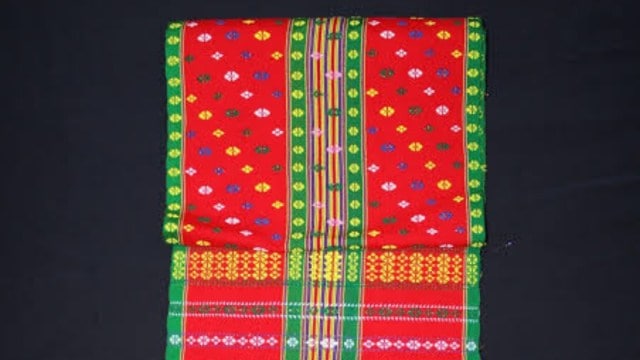Stay updated with the latest - Click here to follow us on Instagram
Tripura’s traditional tribal attire ‘risa’ gets GI tag: CM Manik Saha
Earlier in May 2022, the then Tripura chief minister Biplab Kumar Deb first moved to recognise risa with GI tag that would increase its international popularity and marketing potential.
 Risa is common in almost all 19 indigenous tribal communities of Tripura. However, each community has its own design. (Photo: Manik Saha/ X)
Risa is common in almost all 19 indigenous tribal communities of Tripura. However, each community has its own design. (Photo: Manik Saha/ X)Almost a year after Tripura’s iconic queen pineapple got the Geographical Indication (GI) tag among 13 other products from the Northeast, a traditional tribal attire too has also been bestowed with the recognition, Chief Minister Dr Manik Saha said in Agartala on Sunday.
The Killa Mahila Cluster of Gomati district promoted by Tripura Rural Livelihood Mission (TRLM) obtained the tag. “Heartiest congratulations to all artisans particularly those from Killa Mahila Cluster promoted by TRLM on ‘Tripura Risa’ getting GI (Geographical Indication) Tag. This will definitely help our signature garment to get international recognition,” CM Saha posted on his X handle.
Heartiest congratulations to all artisans particularly those from Killa Mahila Cluster promoted by TRLM on ‘Tripura Risa’ getting GI (Geographical Indication) Tag.
This will definitely help our signature garment to get international recognition. pic.twitter.com/57SAwKeLIo
— Prof.(Dr.) Manik Saha(Modi Ka Parivar) (@DrManikSaha2) March 3, 2024
Tripura’s BJP-IPFT government has been promoting the traditional risa, a handwoven cloth used by indigenous communities, as a signature identity of the state since the party came to power in 2018. During their visits to Tripura, Prime Minister Narendra Modi, Home Minister Amit Shah and others were greeted with the risa. Now it is being branded under India Handloom.
Earlier in May 2022, the then Tripura chief minister Biplab Kumar Deb first moved to recognise risa with GI tag that would increase its international popularity and marketing potential. The traditional Tripuri female attire consists of three parts — risa, rignai and rikutu.
Risa is a handwoven cloth used as a female upper garment, and also as headgear, a stole, or a present to express respect. As an upper garment, it is wrapped around the torso twice. Rignai is primarily worn as the lower garment and literally means ‘to wear’. It can be understood as an indigenous variety of the sari of mainland India. Rituku is mainly used as a wrap, or like a ‘chunri’ or a ‘pallu’ of the Indian saree. It is also used to cover the heads of newly married Tripuri women.
These garments were traditionally handwoven. Handloom remains an integral part of the Tripuri household, even with the advent of powerloom-manufactured garments.
The complete Tripuri attire is claimed to have originated even before the time of the Manikya kings, who ruled Tripura for over 500 years starting from the 15th century. Although this history is contested, Maharaj Trilochana aka Subhrai Raja is said to have invented nearly 250 designs of rignai during his time for his 250 wives.
Woven in colourful designs and worn as an upper garment, the risa also has a crucial social and religious significance. Adolescent Tripuri girls are first given a risa to wear in an event called Risa Sormani, at age 12 to 14.
The risa is used in religious festivals such as Garia Puja by tribal communities, a turban by men during weddings and festivals, a cummerbund over the dhoti, a head scarf by young girls and boys, and a muffler during winters. The cloth is also used as a makeshift hanger to hold an infant on mothers’ backs. And it is presented as a mark of honour to distinguished recipients.
Risa is common in almost all 19 indigenous tribal communities of Tripura. However, each community has its own design.







